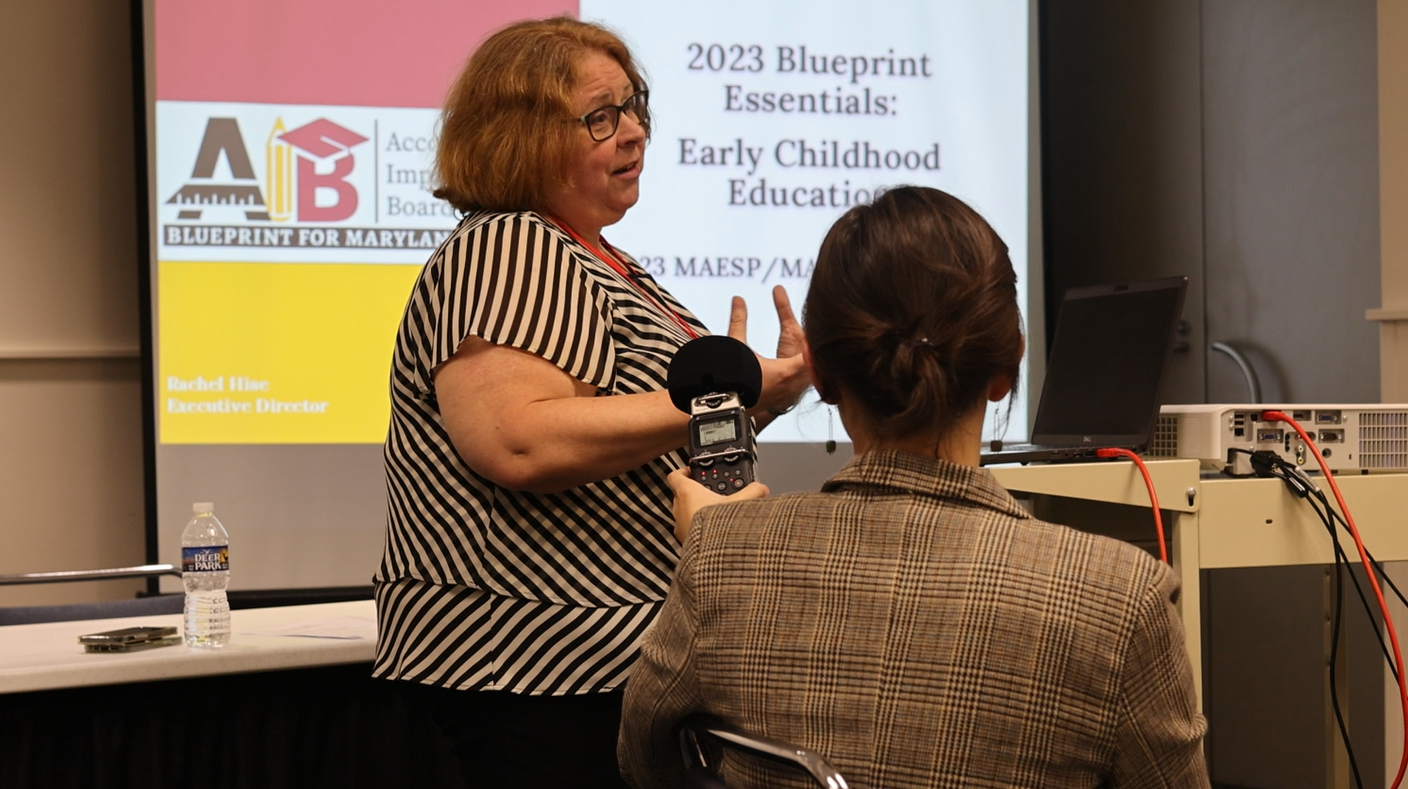OCEAN CITY, Md. – As Maryland rolls out the 2021 landmark education reform law called the Blueprint for Maryland’s Future, many school administrators are unsure what the plan means for their schools.
At the annual School Leaders Conference held Nov. 2-4 in Ocean City, state officials and school principals reviewed the details of the Blueprint and discussed how it will be implemented in each school district.
The wave of impending policy changes are meant to address the challenges facing educators and students across the state. For example, Emily Abell, principal of Monarch Global Academy in Anne Arundel County, said her school is experiencing the effects of the nationwide teacher shortage.
Asked about the Blueprint, she said: “Is it gonna help? I don’t know. We’ll have to see what it looks like on paper and when we start to implement.”
The Blueprint is grounded in the analysis of a group of independent policy experts formed by the state in 2016 to establish a baseline for education reform. Though formally named the Commission on Innovation and Excellence in Education, the group was commonly referred to as the Kirwan Commission after its chair, William E. Kirwan, chancellor emeritus of the University System of Maryland.
By 2019, the Kirwan Commission had come to some sobering conclusions about Maryland’s education system. Half of all teachers leave the profession within the first five years. Only two out of every five kindergarteners arrive in the classroom ready to learn. And just a third of students leave high school being “college and career ready” in English and math.
“That was pre-pandemic. So generally speaking, it’s gotten worse,” said Rachel Hise, a policy specialist who worked for the state in tandem with the Kirwan Commission. Explaining the commission’s findings to school leaders in Ocean City, she said the independent body concluded that “ultimately, the status quo is unsustainable.”
Because of the work of the Kirwan Commission, the Maryland General Assembly passed the Blueprint for Maryland’s Future in February 2021, overriding a veto by then-Gov. Larry Hogan, a Republican who had cost concerns about the plan.
The Blueprint allocates $3.8 billion to schools over the next 10 years and is based on five “pillars.”
- Pillar 1: Early Childhood Education, which includes the expansion of pre-K to three and four-year-olds through both public schools and private providers.
- Pillar 2: High Quality and Diverse Teachers and Leaders, which mandates raises in teacher salaries and incentivizes them to attain National Board Certification.
- Pillar 3: College and Career Readiness, which establishes changes to high school curriculum, technical training programs and opportunities for apprenticeships.
- Pillar 4: More Resources to Ensure that All Students are Successful, which provides more money to schools in need.
- Pillar 5: Governance and Accountability, which creates a framework of oversight led by the Accountability and Implementation Board, the state agency created to administer the plan.
Hise is now executive director of the Blueprint’s Accountability and Implementation Board. She said the policy changes will make sure students are ready to learn in kindergarten and ready to succeed when they graduate high school.
“The Blueprint is aiming to have all 4-year-olds in public full-day pre-K,” said Hise.
Because public schools lack the capacity to fulfill this mandate alone, the state will fund programming via private pre-K providers as well.
“The goal is a socioeconomically integrated pre-K system that is publicly funded, but that is provided by both public schools and private providers,” Hise told administrators in Ocean City.
The Blueprint will also mean big changes in high schools.
“What the Blueprint really envisions is we want kids to be college and career ready by 10th grade, so that the second two years of high school students can focus on the pathway that they’re interested in pursuing,” Hise said.
The Blueprint aims to meet this goal through curriculum changes in English and math in addition to apprenticeships and technical education programs.
Implementing the Blueprint at the school level falls squarely on school administrators, said Addie Kaufman, executive director of the Maryland Association of Secondary School Principals.
“There was no doubt that the Blueprint would be a part of this conference, and the understanding of the Blueprint is actually key,” she said in an interview.
After learning more about the Blueprint at the conference, some principals said they are hopeful that the reforms will address their schools’ priorities.
Teachers are struggling to make do with salaries in the current economy, said Principal Ryan Daniel of Fort Foote Elementary in Prince George’s County.
“I know a lot of my teachers have to have after-school jobs or second jobs to compensate for their salary,” she said.
The Blueprint will raise the minimum salary for teachers to $60,000 across the state by 2026. And if teachers obtain National Board Certification, the Blueprint allows them to earn up to an additional $17,000 per year.
“I am excited for the Blueprint for Maryland,” said Sarah Bento, an assistant principal at Northern High School in Calvert County. “The Blueprint is really asking us to rethink what high school looks like and really make sure that we’re preparing all of our students to be prepared to go to college or enter the workforce in a way that we just haven’t done before.”
Thanks to the Blueprint, Bento’s school has been able to hire a career advisor for the first time.
“We have 1,500 students and he’s meeting with every single one of them to talk about career entrance and get them connected to the resources that are out there,” she told the Local News Network.
Other schools have yet to feel the concrete impact of the Blueprint.
“Honestly, I’m still reading and learning, and I think that they’re doing a really slow roll out intentionally for us, which is good,” said Jamie Miller, the principal at Broadneck Elementary in Arnold, in Anne Arundel County. “We have people at the board level who are becoming sort of experts and then they’re going to disseminate to us.”
Miller expressed a mix of excitement about the expansion of pre-K and trepidation about her school’s capacity to meet the need.
“I would love to have pre-K in our school,” she said. “Early childhood is a love of mine, so I would love to. But our school building is very, very old and there’s not a place for them.”
It’s hard to implement policy changes while running the day-to-day operations of a school, said Miller.
“So I think the summertime will be a big focus for us when there aren’t kids in the building and we’ll be able to kind of digest it more and be taught exactly what the expectations are,” she said. “I’m eager to see how it all rolls out.”
In March 2023, every school district submitted a detailed plan to the Accountability and Implementation Board for rolling out the Blueprint in their schools.
“The plans are fine, but they really are a baseline,” Hise, of the Accountability and Implementation Board, said. “There’s a need for more innovative thinking.”
The Accountability and Implementation Board expects updated plans from every district in March 2024, and has offered every district a $100,000 grant to hire a strategic planning expert. All but Frederick and Worcester counties took the state up on that deal.
The Local News Network will follow the Blueprint rollout and an analysis of each district-level plan will be published in January on the University of Maryland’s Capital News Service website.


